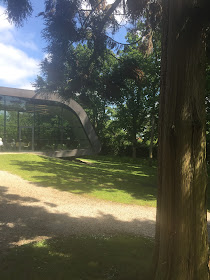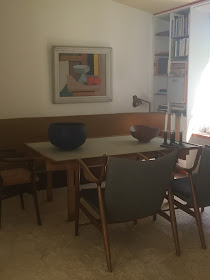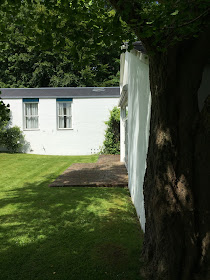....in Ordrupgaard, Copenhagen
Just north of Copenhagen, in the idyllic Charlottenlund, lies the Ordrupgaard museeum, home of one of Northern Europe’s most considerable collections of Danish and French art from the 19th and beginning of the 20th century. But it wasn't this that I wanted to see when I visited last month....
I was more interested in visiting the surrounding art park, where you can experience contemporary art by a number of high-profile artists, such as Jeppe Hein's magical Semi circular mirror labyrinth and other site-specific works made especially to fit into the museum's park surroundings....
Among all the contemporary works on display in the park, I found Jeppe Hein's work the most fascinating, as the use of mirrors invites the visitor into a fascinating, kaleidoscopic universe.....but also the way his installations reflect the greenery and changing light of the park, and most importantly reveals glimpses of the architectural gem that is the Ordrupgaard extension to the museum:
The deconstructive extension to the original gallery building ,consisting of a three-winged trellised country mansion in the neo-classical style, was designed by radical architect, designer and painter, Zaha Hadid .
This spectacular structure works with its surroundings and perfectly juxtaposes the old museum building with both it's form and choice of materials: Like a gem sitting in the landscape, Zaha Hadid's ultra modern building is made from black concrete that changes color and texture depending on the weather. It can thus be both dull and gray and shiny black....
The buildings design does not only let the surrounding nature and natural light become part of its architecture, but the use of curved and slanted walls inside helps create an intimate atmosphere as well as wonderful acoustics, as I found out on my visit as there was a jazz concert in the main hall of the building that day....
And as another contrasting element , the foyer of the buildings cafe is furnished with mid century modern Finn Juhl Pelican chairs, wich brings me nicely around to what was the main event for me on my visit to Ordrupgaard:
FINN JUHL'S HOUSE
Within the grounds of the Ordrupgaard park, hidden by a surrounding hedge, you will find an unassuming looking house, that is anything but....
Built in 1942, this house has a modest and almost utilitarian feel to it, typical of design coming out of wartime Europe, and looks quite unassuming from the outside...
But this is not an ordinary house....listed as one of the world's most iconic houses, this was the home of Danish architect and furniture designer Finn Juhl.
Most known for his furniture design, Finn Juhl was one of the leading figures in the creation of "Danish design" in the 1940s and he was the designer who introduced Danish Modern to America, sparking the Mid century modern design movement there...
And this, his private home was his stage upon which he could try out his ideas about design:
Finn Juhl's approach to architecture and design was unique as he did not put the building first, but rather strived to attain a coherence in every detail, hence his forays into furniture as well as textile and tableware design.
The architecture and interior of the house is inextricably linked to the outside surroundings:
"The light, translucent character of the gardens flora and the house's colors, materials and construction is intended to continue into the interior through the furnishings, color choice and furniture."
Finn Juhl
And as well as emphasizing this artistic harmony, his use of materials, color combinations and designs that make up his home, form a scene where furniture, paintings, utensils and sculpture find their place and allow daily life to unfold in a very functional way.
Finn Juhls house is a testament to his complete thought process behind everything that he did: A unity of things, from practical, but beautiful furnishings, to carefully selected art and crafts by his contemporary's alongside his own iconic furniture designs.
Finn Juhl’s “from the inside and out”-philosophy is today used as a model for user-driven innovation in modern industrial design.
Finn Juhl died in 1989, but his home is today seen as a treasure trove from a significant époque in Danish design history
The house is now a museum and provides an opportunity for the public to feel and sense the design ideas, which became known as Scandinavian Modern.
Curious to see the house?
Here's a few snaps I shot on my visit:
(Please excuse the foggy lens, this was shot shortly after having a delicious Danish pastry at the cafe )

I felt that upon a basic, modest utilitarian background (See the kitchen), typical of the wartime era, Finn Juhl has brought a very bohemian and artistic feel to his home through his choice of art and beautifully crafted furniture. There is a definite coherent and functional style to his home, and you'd definitely perceive this to be a working home, designed to live in...
All the houses furniture is designed by Finn Juhl, and you can see some of his most iconic chair designs, like the FJ45, the FJ46 and the Chieftan chair. I loved the Poet sofa, situated by the living room's fireplace, in front of the portrait of Juhl's partner , Hanne Wilhelm Hansen, by the modernist, Danish painter Vilhelm Lundstrom.
Something in me really related to this place...It could be the nostalgic memories the utilitarian style of Finn Juhl's house evoked in me, reminding me of my grandparents home in Norway. Or that it's furnishings appealed to my love of Mid Century modern style design ....
...But in retrospect I think that Finn Juhl's centiment that modern free-forms and colors of arts and crafts were an inseparable part of modern home decor, so evident in his home through the display of art and design by his contemporaries (such as Asger Jorn, William Lundstøm, Egill Jacobsen, Richard Mortensen and Erik and Anna Thommesen), along with his " I'll make it myself" attitude to creating a coherent interior is what I found most inspiring...
And the way this iconic home combines beauty and functionality within all aspects of it's design, down to the smallest detail, making it a home for living and working in.
A unique example of The Danish modern epoque within architecture, furniture design and visual art, a visit to the Finn Juhl's house provides you with a snapshot of an era where design was considered instrumental to peoples quality of life, so typical of Scandinavian design tradition.
Finn Juhl's house showcases the beauty of Scandinavian functionalism and resourceful craftsmanship, and in my opinion it is not just the designs, but also the focus on quality, pioneered by Finn Juhl and his contemporaries, that has ensured the continuing popularity of mid century modern design and furniture today, hailing them as classics.
If you are the least bit interested in the history of modern design, which I assume you are if you are reading this, I would highly recommend that you visit Finn Juhl's house and the Ordrupgaard museeum and art-park should you ever visit Copenhagen.
I know, I for one, came away inspired...
....and in the spirit of Finn Juhl, I decided to try my hand at furniture making, making my own sideboard for the livingroom, as seen in my previous post here....this way getting exactly what I wanted both in terms of style and function...
I will be posting the tutorial on how I made it in my next post, so do pop back for that later this week!
In the mean time: have a good one peeps!
































sàn gỗ thái lan 8mm, 12mm chính hãng
ReplyDeletesàn gỗ Thái Lan có tốt không, giá bao nhiêu, mua ở đâu giá rẻ